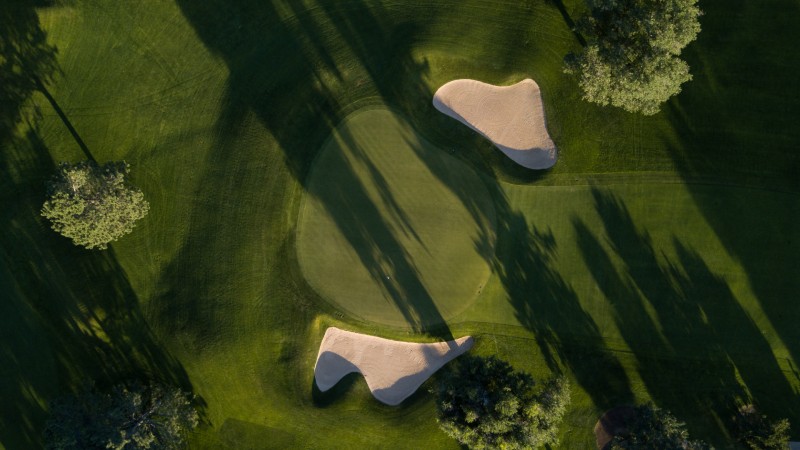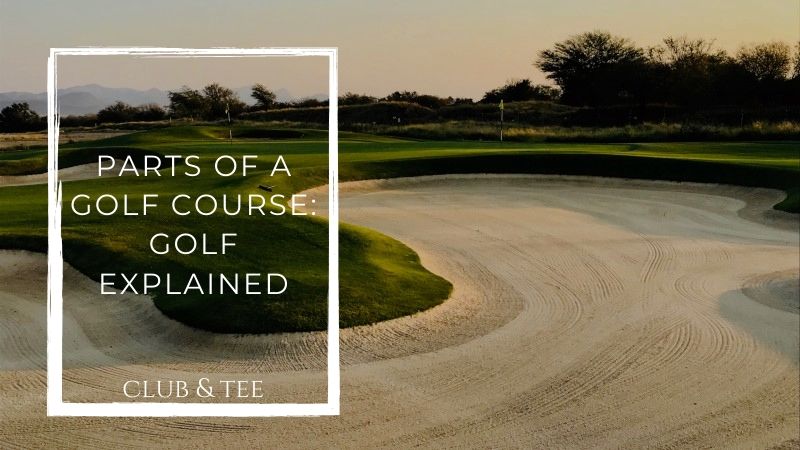We all know that a golf course will have some grass, holes, and probably some sand, but what should you expect to encounter when you visit a club?
Continuing on our theme of golf terminology for those that are still learning, we thought it would be a good idea to explore the different parts of a golf course. Even if you are still learning to play, you can talk like a seasoned pro.
You may also like:
- Why Should You Not Opt For A Cheap Golf Rangefinder
- How to Hit a Golf Ball Farther – A step by step Guide
- How to Break 100 in Golf Consistently | Easy Tips | Advice
Before you tee it up

- Pro Shop – This is effectively the store at the golf course. You go inside to check-in, pay for your round, rent a cart, and buy any supplies you may need for your round (golf balls, tees, etc.). There may be a snack bar if you need to fuel up prior to your round.
- Cart Barn – most courses no longer leverage an actual barn but have some sort of structure or building where they store the motorized carts that you can rent if you do not want to walk the course.
- Driving Range – where you go to warm-up and practice your full shots prior to your round. You may encounter mats or hopefully, it will be grass. Typically, the balls will be marked as “practice” or painted with a line and they are not to be used on the course. The driving range will have targets at various distances.
- Practice Green – may also be called the Putting Green. Typically, a green near the Pro Shop that has multiple holes and is used to practice your short game before you tee off. Chipping is sometimes prohibited, so look for signs that provide the rules for the practice green.
- Starter/Marshall – many courses will have a club employee whose job is to manage the 1st tee process – make sure groups go off in the correct order and follow the rules of the club. They may also drive around the course to monitor for pace of play or see if golfers need any assistance.
On the course

- Tee Box – this will be the start of each hole – a closely mown area that you place (typically tee up) your ball and hit your first shot. There will be multiple color tee makers on each hole to designate Ladies, Senior, Men’s, and Professional tees.
- Fairway – also known as the “short grass” – this is where you are trying to hit your drive. Hitting the ball down the fairway should always be your goal.
- Rough – longer grass outside of the fairway – typically much harder to play from, this is considered a penalty to the player that cannot hit the ball straight. Length of the grass in the rough will vary from course to course.
- Yardage Markers – hitting the correct club into the green will be critical to your score and yardage markers are placed on the course to help you figure out how far you have to the hole. They will vary course to course, but most either have different color stakes (blue = 200 yards, white = 150 yards, red = 100 yards) or they have plaques in the fairway. The best way to leverage them is the find the nearest yardage marker to your ball and count off how many strides you are away from it. For example, if you are 16 strides farther away than the 150-yard marker, your shot is 166 yards.
- Green – each hole will have a green and this is where you will find the flag and hole. This is the shortest grass on the course, and you should use your putter on the green. The key to good putting will be learning to the “read the green” and determine which way your putts will break. Green speed will vary from course to course, so it is important to hit a few putts on the practice green before your round.
- Fringe – A thin strip of grass between the fairway or rough and the green. The fringe surrounds the green and most players will putt from the fringe. The grass on the fringe is slightly longer than the green.
Parts of a golf course you want to avoid
- Sand Traps – also referred to as “bunkers”, these are carved out areas filled with sand. Depending on the course, they may be next to the green or out in the fairway/rough. They can be quite challenging to play from if you are new to the game.
- Hazards/Penalty Area – usually marked with red or yellow stakes, if your ball finds one of these it will cost you a 1-stroke penalty. Typical examples of hazards you might encounter include lakes, creeks, swamps, and wetlands. The rules get complicated quick, but basically, if you hit it in one, you take a drop and add a stroke.
- Out of Bounds – the worst place you can go on the course is hit your ball off the course! Out of bounds is typically marked with white stakes or a white line. At most courses, hitting it out of bounds means you ball went across a road or into someone’s backyard. The penalty for going out of bounds is “stroke and distance”, which means you replay the shot from the same location and add a stroke. For example, if you hit your tee shot out of bounds, you take a stroke and hit it again, so you are hitting your 3rd shot.
After you finish your round
The light at the end of the tunnel if you are having a tough day. When considering all parts of a golf course my favorite is often the 19th hole! A slang term golfers use to describe the golf course bar & restaurant. A great spot to hang out with your playing partners, talk some trash, and enjoy a cold beverage. There is nothing golfers enjoy more than talking about their rounds and the 19th hole is the perfect spot for this activity.
Even if you play a terrible round and shoot a gigantic score, you can be the champion of the 19th hole!


